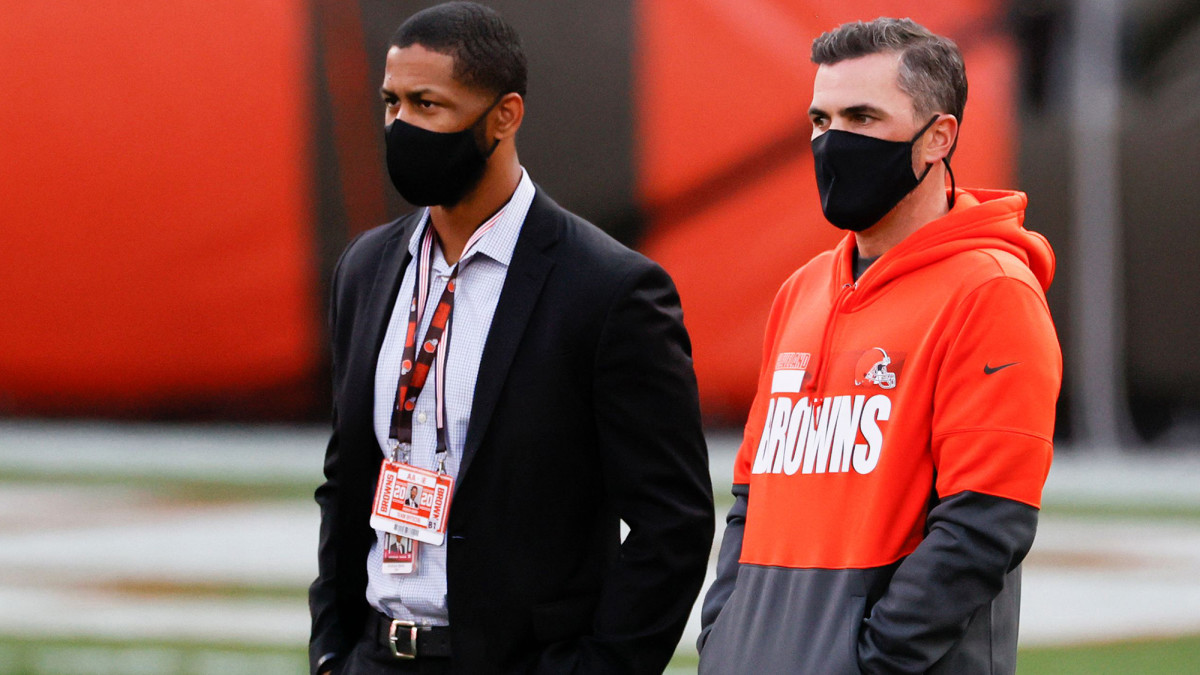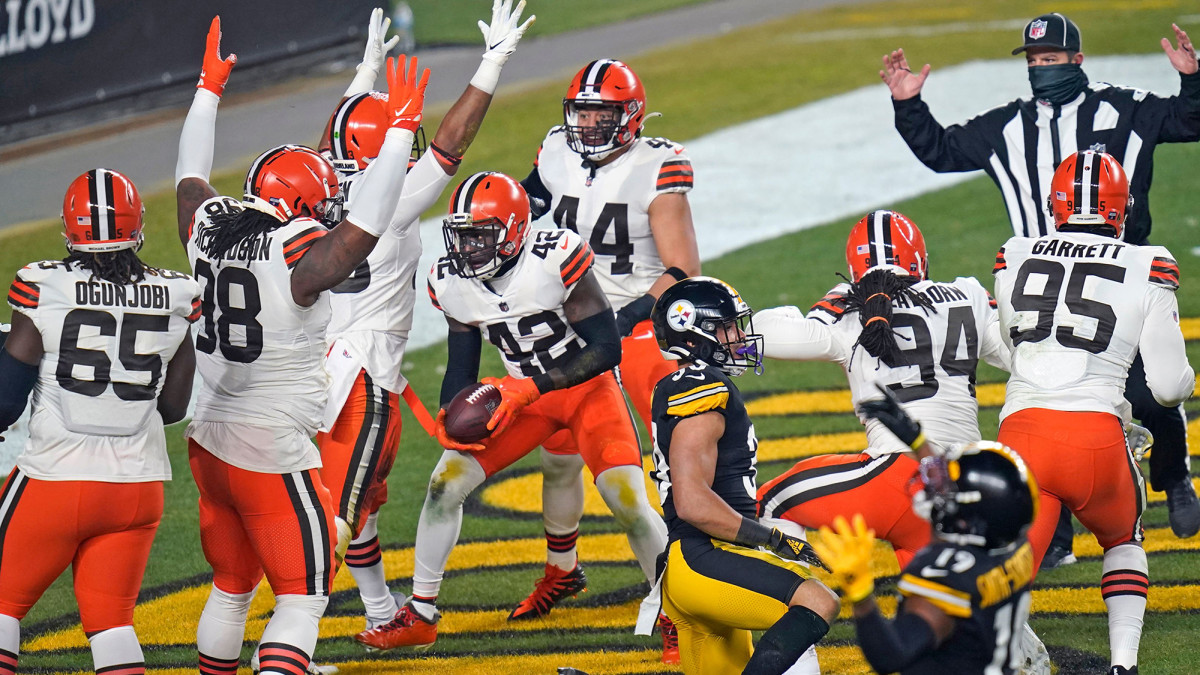Serenity Now: How the Browns’ Zen Masters Transformed the Team’s Fortunes
Browns general manager Andrew Berry thinks head coach Kevin Stefanski is funny.
And not just funny in the kind of way that mutual work acquaintances consider each other slightly more than tolerable, but actually, endearingly funny; funny like when your friend says something that still makes you laugh a few days later.
An example: Last week on a Zoom call Stefanski was sitting in his basement, forced to quarantine both from his team and his family due to a positive COVID-19 diagnosis that would prevent him from coaching that against the Steelers in the opening round of the playoffs. During a lull in the conversation, Stefanski looked up and said out of nowhere in a perfect deadpan: “Man, I feel like Sloth from the Goonies in this basement. Like, my wife is just leaving me food at the top of the stairs.”
“He’s just … he’s got this … he’s hilarious,” Berry says through a chuckle.

We present this relatively banal tidbit as a small piece of evidence why the Browns are here, playing on Sunday against the Chiefs for the chance to reach the AFC title game. Of course they are well built, well coached, talented thanks to years of high draft picks and cap space and, like most postseason teams every year, have gotten some of the requisite in-game breaks and bounces along the way (one cannot plan and execute a snap being launched over the opposing quarterback’s head and into the end zone, after all). But they are also here because they seem to really like and care about one another, both in the locker room and at the highest rungs of the organization, which any scholar in modern NFL palace intrigue—or anyone with an internet connection—will tell you is not always the case in Cleveland. In the past, across various regimes and power structures, the team has been associated with a yearly ritual of hiring, firing and bracing for the salacious article about why and how it all fell apart. Football people vs. personnel people. Analytics vs. scouting. So on and so on.
Now they feel, in corporate football speak, aligned, and while that might not seem like a big deal for anyone not preparing a TED talk on management theory, the success of this very purposeful endeavor led by Berry, Stefanski and chief strategy officer Paul DePodesta has helped make Cleveland a force to be reckoned with in one of football’s toughest divisions and in a most unpredictable, pandemic-rattled season.
“It’s something we feel internally, and if that emanates externally that’s pretty cool,” Berry said just after practice on Wednesday. “I also think that we were all pretty conscious of the fact that we could say one thing, but ultimately that would just be words on a page if we’re not able to execute it.”
Through a virtual offseason with a first-time head coach, a virtual draft with the youngest general manager in NFL history and a virtual week of practice leading up to their first playoff win in more than a quarter of a century (in which some of their top coaches and players could not participate), the Browns believe they have a grasp on what keeps their group of people together during one of the most outwardly chaotic times in modern American history. Cleveland was the only team with a head coach who had never held the position before to make the playoffs in 2020.
Time will tell if a calculated effort to foster mutual respect and admiration will survive in the notoriously cold-blooded, ego-dominated world of the NFL, but for now the team’s journey appears to be an instructive one.
This is how the Browns arrived at a moment of inner peace.
When the team closed its facility doors on March 13, those at the top of the Browns’ organization did not fear the logistics of pivoting to a virtual, work-from-home setting. Their coach and GM were comfortable with computers. There was a push dating back a few years to update the organization’s technology infrastructure.
The task was fostering togetherness, both between a head coach who had only spoken to a few of his players during casual, one-off meetings and between players who may not have met one another, either. This was the subject of meetings between Stefanski, DePodesta and Berry, who had been workshopping ideas to maximize the team’s in-person time together before the shutdown. Their initial plan centered heavily around the idea of spending meals together as a way to forge bonds, along with some other planned activities, like bowling, that are typical training camp staples. During the pandemic, with players scattered across the country jumping in on calls between spartan backyard workouts and childcare responsibilities, this was not only impossible, but illegal.

One of the solutions was an exercise that Stefanski had borrowed from Virginia Commonwealth basketball coach Mike Rhoades called the Four H’s. The H’s stand for History, Heroes, Heartbreak and Hopes and was spread throughout various meetings during the summer. Different members of the coaching staff, the team and the front office were asked to dig into their pasts and bare their souls, releasing a dossier of personal information from each of the categories that could give their teammates a better idea of who they are. This tied players through various emotional circuits, such as those who had lost a parent at a young age.
“Kevin created this environment where people could show their personalities and really be unmasked in a non-football way,” says the 33-year-old Berry. “That went a long way toward building the camaraderie that was needed for a team once we got into August [when in-person practices began].
“It’s the idea of making people be vulnerable to a group, and I think it was something that paid major dividends for us.”
During winning seasons, so much of the work done early in the year becomes bigger in hindsight, as it fits nicely into a narrative arc. Giants fans like to talk about Tom Coughlin’s personality softening back in the mid 2000s and how it was a precursor to the team’s Super Bowl run in 2007. Coaches who come in and instill a hard-hitting, throwback practice regimen are praised for toughening up teams, and coaches who pull back the reins following the era of a tyrant are praised for how their relaxed style allowed the group to play faster, smarter and injury free. Of course, there is no telling if one specific meeting or action led to an eventual success, or whether it was simply used as an entertaining footnote after the fact for what could be a very short story: This team was bigger, stronger, faster or smarter than anyone else.
With Cleveland, though, it is worth noting how deliberate all of the emotional underpinnings of the 2020 season seem to be. While no one in Cleveland is saying it expressly, it feels like an organization teaching itself how to win and how to care from scratch. Berry, now in his second stint with the Browns after serving as Hue Jackson’s player personnel director between 2016 and ’18, and Stefanski spent hours in each other’s offices before the pandemic and on Zoom after the shutdown talking about ways to make everyone feel like they had a hand in what was to come.

At one of Berry’s first staff meetings, he went so far as to ask everyone to simply come in to work every day with a positive attitude, which seems like innocuous guidance counselor poster fodder. With Berry, it was a staple of good general managers he’d worked for in prior stops, like Bill Polian in Indianapolis and Howie Roseman in Philadelphia. So no matter the circumstance, in person or virtual, the energy had to be right.
Now, with perfect hindsight, is it a moment that seems wildly prophetic or just a coincidence? How many coincidences need to occur before a process can be credited with success?
“A season is hard enough where you have to go to work excited, ready to go and mostly solution-oriented,” Berry says. “That’s most important in times of adversity when the team is struggling or something unexpectedly negative happens over the course of the year.
“For me, I’d just seen it enough where particularly when leadership goes in a different direction, it has such a debilitating effect on the culture of the rest of the organization. So that’s always been something that’s important to me.”
The draft is quietly one of the most perilous events for a regime because so much of their personality — Can they work with others? Do they take advice and criticism well?— will be revealed in a short period of time. When selecting college players, information comes from every part of the organization, which heightens the chances that someone will feel slighted for their work being ignored, particularly the area scouts combing the country for months at a time away from their families.
This is especially true if all meetings are held virtually.
In Cleveland, Berry, Stefanski and DePodesta tried to be aggressive and methodical in their inclusiveness. When their first “95% complete” Big Board was revealed in an April meeting, it was the culmination of feedback received from the scouting department on what they thought of the players, the coaching staff on what they needed, the research and strategy team and the character/background information/mental assessment team. They identified placements on the board that were specifically “hot button” that would generate conversation and steered the meeting directly toward where the disagreements would arise.
“I think the worst thing you can do as a general manager is make a selection that comes out of left field,” Berry says. “Everyone is wondering where it came from. People may not always agree, but if they can understand the sequencing and the logic and understand all the different perspectives were weighed, that’s generally something people can respect and get behind.”
The important part, Berry says, is what comes next. The Browns’ top brass send out a survey to the personnel department, the contract management department, scouting, research and strategy and coaching departments asking a wide-ranging group of questions from everything on how the meeting was structured to how the big board was put together and how effectively information was communicated from the top down.
The results of the survey are discussed internally and tabulated, then sent back to everyone who participated along with an “action plan” that includes changes planned for the next draft cycle that came directly from the survey results. Berry said he is confident that next year’s draft will look a little bit different than this year’s, which is the point.
If it sounds like the Browns have a lot of meetings, that’s because they do, though none that stretch on endlessly. The point comes full circle when imagining the ideal scenario: When everyone feels heard and is constantly checked in with, fewer people feel slighted and, as Berry asked his staff back at the beginning of the season, more people can come to work every day with a positive attitude.
In some ways this is simple and bare bones. Every new head coach and general manager seems to come into their building with a nebulous signature saying: Row the boat; Chop the wood; Every rock, every day. They all mean the same thing in theory, but how much infrastructure is actually behind the ideas? How do you measure wood chopping and boat rowing?
Might a survey actually help?

By the time the Browns arrived at Jan. 5, the day Stefanski’s positive COVID-19 test and the positive tests of several other critical staff and players were revealed, Berry says that he did not sense a frantic atmosphere in the building (or outside of it once the facility was shuttered). Maybe after a year of compartmentalizing, quantifying and attacking problems in small, actionable pieces, nothing felt so intimidating anymore.
“I wouldn’t describe it as chaotic,” he says. “Certainly challenging from the perspective that we spent a lot of time with our medical staff, the league’s medical staff and people like [NFL chief administrator of football operations] Dawn Aponte. But in terms of chaos in the building, we felt like we had gone through enough where our guys were pretty pliable.
“We were good at focusing on the things we could control as opposed to the things we could stress out about and not control. In a short amount of time, we’d been through a lot as a group together. It felt like business as usual.”
The players were comfortable receiving instructions virtually. The coaches were comfortable disseminating marching orders virtually. Everything down to the necessity for quality depth had been buttoned up.
After the Browns beat the Steelers, Baker Mayfield joked that he had met a player for the first time that day, a guard named Blake Hance who had to play late in the game due to an injury to Joel Bitonio’s backup, Michael Dunn (Bitonio was also out due to a positive COVID-19 test). The truth was that Hance was signed from the Jets’ practice squad before the team’s regular-season finale, also against the Steelers. Cleveland was planning on recruiting Hance to a reserve/futures deal after the end of the season but due to earlier COVID-19 issues that predated the wild-card week outbreak, decided to add Hance to the roster now just in case the need arose.
“Blake was a guy we identified earlier in the month. We worked him out earlier in the year,” Berry says. “Then, when we had the COVID issues with our offensive staff, we were concerned about what that might mean for the offensive line. So we said, hey why don’t we go ahead and sign him now as opposed to after the season in case we had any additional COVID issues that trickled into the week of the wild-card round.
“We had done the work on Blake, which is a credit to our pro personnel staff. We liked his upside as a prospect anyway and it just made sense. We wanted to have some protection at the position group. He also had a history with our offensive line coach Bill Callahan [when both were with the Jets]. That’s not why we made the move, but it ended up being a little bit of a bonus.”
Again, it all fits together. A guy who was identified by the pro personnel department, passed to the coaching staff and the general manager ends up seamlessly plugging into a hole during a time when some sidelines would be melting down due to the increasing weight of all the external stressors.
As Cleveland’s run into the playoffs continues, as its second draft materializes, as its first (hopefully) in-person offseason commences, we’ll see whether this season was a grand coincidence —the kind of cosmic payback due to a franchise that had suffered for so long—or whether a process grounded in liking and listening to one another begins to grow roots in Cleveland. One thing is for sure: If something is tangible enough to be discussed and improved upon, there will be a discussion.
Which brings Berry to a final point just after 4 p.m. on Wednesday, a few days before the team will board a plane to Kansas City. He’s actually running to a meeting now with Stefanski, all of the assistant coaches, the team’s director of performance and head of medical to ensure everyone is on the same page in terms of daily business on injuries, roster moves, game prep and Thursday’s practice schedule.
Says the GM, “That’s something we make a habit of doing every day.”
